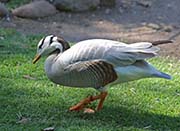Bar-headed Goose - Anser indicus
| Length | |
| Wingspan | |
| Weight | |
| Clutch Size | |
| Chicks at birth | |
| IUCN Conservation Status | |
Continents: |
The Bar-headed Goose is mostly found in the Indian subcontinent. They fly the highest of any bird as they migrate across the Himalayas. The other amazing feat is that they accomplish this flight in a less than a single day (7-8 hours).
The Bar-headed Goose body is mostly shades of gray (sometimes brownish) with white tail coverts and rump. The head is white with two black bars on the head. One bar is from eye to eye across the head, the other is a lower and extends from ear to ear across the neck. The back of the neck is black or brown with a white strip on the sides. The front of neck is mostly gray. The iris is brown. The bill, legs and feet are orangish-yellow and the bill has a black tip. Both sexes are identical in plumage. Juveniles are similar but the head is pale gray and the black areas on the neck are more brown.
Diet: They feed on vegetation found on the ground or in water. Diet includes grasses, tubers, grain crops and sedges. On the coast they also consume seaweed.
Courtship: Bar-headed Geese are a gregarious bird and will gather in flocks of over a hundred birds.
Nesting: Bar-headed Geese are colonial nesters. Nests are built on wetland plateaus 4000-5000m (13,100-16,400 ft) and frequently built on the ground but may are also be built on rocky outcropings and sometimes in trees. Preferred locations are islands in marshy lakes. The female builds the nest from piles of mosses and other vegetation. The female does all the incubation and both sexes defend the young.
Habitat and Range: Breeds mainly in Mongolia and China and winters in western China, Tibet, India, Pakistan, Breeding habitat preferences is highland plateau wetlands. Winters mainly in lowland swamps, lakes and rivers. Feral populations are also found in Europe.
Vocalization: Nasal honking while in flight, otherwise makes cackling sounds.
Plumage/Molt: No alternate plumage.
Migration: Bar-headed Geese are mostly migratory. Part of their migration is across the Himalayas. This flight can take them as high as 21,000 feet (6,400 m) but they usually fly below 19,000 feet (5,700 m). To fly this high certain adaptations are needed including the ability to breathe more deeply and efficiently under low oxygen conditions. Also, other adaptations allows them to deliver more oxygen to their muscles faster and their wings are slightly larger than other geese.
Tongue/feet: Legs and feet are orangish-yellow.
Bibliography:
- http://en.wikipedia.org The Free Encyclopedia, Accessed February, 2014
- http://animals.nationalgeographic.com/animals/birds National Geographic, Accessed February, 2014
- http://wildpro.twycrosszoo.org Electronic encyclopaedia and library for wildlife, Accessed February, 2014
- del Hoyo, Josep, Elliott, Andrew, Sargatal, Jordi, et.al., Handbook of the Birds of the World,Lynx Edicions





